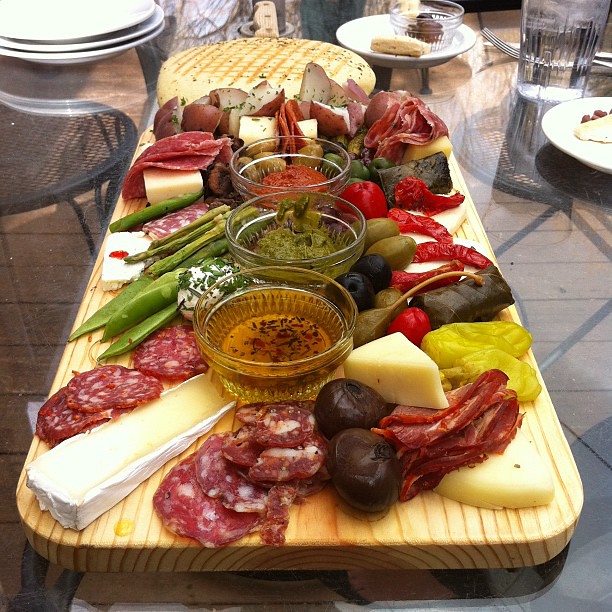
Anyone who thinks their Thanksgiving tradition of roasting a turkey and mashing potatoes is complicated should talk to Theresa “Terry” Scotto-Spinelli. This lifelong and well-known local around Carroll Gardens knows a thing or two about holiday feasts.
Many days, Scotto-Spinelli can be found working in Scotto Funeral Home, which was founded by her parents in the 1920s. However, on Thanksgiving, you will find her hard at work in the kitchen.
As the daughter of two Italian immigrants, Scotto-Spinelli’s Thanksgiving preparations begin the Italian way – with a lasagna in the oven on Wednesday night before the big day. She explains, “I make the lasagna the night before so it isn’t mush when you take it out.”
Lasagna, not commonly served in stereotypical Thanksgiving scenes, is a popular holiday dish amongst Italian-Americans.
Scotto-Spinelli starts hers off on the stovetop, making the gravy, or sauce, with a mixture of onions, garlic, seasoning, and a variety of tomato products.
She lets them cook down for about an hour and a half, meanwhile boiling noodles and making her famous meatballs. She rolls out golfball-size chunks of meat, seasoning, egg, and bread crumbs. Afterwards, she fries them on each side and sets them aside for later. Smiling brightly, Scotto-Spinelli confides, “I make good meatballs. They’re very popular.”
With layers of sauce, noodles, ricotta mixture, and crushed meatballs piled high, Scotto-Spinelli puts her dish in the oven. She takes it out, cools it, and sets it aside for the following day.
Thanksgiving Day begins with church for many Italian-Americans. “We like to go to church in the morning around 9 am,” Scotto-Spinelli relates, “We thank God for all our blessings.”
Additionally, she says that she tries to go to the cemetery to visit her parents and her late husband. Amongst Italian-Americans, as with many others, Thanksgiving is first and foremost a holiday about family.
Upon returning home after church, the rest of the cooking commences.
Scotto-Spinelli explains, “For the old-timers, dinner starts with antipasto, then lasagna, turkey with all the trimmings, and all kinds of desserts, of course.”
Similar to stereotypical American feasts, Scotto-Spinelli whips up turkey, sweet potatoes, vegetables, gravy, cranberries, and stuffing. But in addition, she makes roasted chestnuts, baked asparagus coated in egg, breadcrumbs, and cheese, and stuffed artichokes filled with garlic, parsley, and bread crumbs.
All of this work in the kitchen is not even the half of it. A great deal of time is spent in stores, searching for the right ingredients and various side dishes.
Scotto-Spinelli’s first course, beginning around 5 pm, is antipasto. Mozzarella and assorted peppers, artichokes, and olives come from Caputo’s Fine Foods. Antipasto meat, along with the meal’s other meats, comes from G Esposito & Sons. Locals like shopping at the neighborhood stores because “they just taste better.”
After antipasto, Scotto-Spinelli says that everyone gets distracted by conversations and football, but eventually it’s time to regroup for the lasagna course. Reheated just before dinner, the lasagna comes out and everyone fills themselves with noodles piled on noodles.
A full meal on a regular day, lasagna can be a challenge to get past, especially for some of the younger members of the family. “The old-timers like to keep eating. The younger people are moving away from old-fashioned ideas about having all the food.”
If the lasagna course is not enough to hold you over for the year, the third course looks a lot like what people might expect to find at a typical American holiday meal, with a few additions and Italian twists.
Turkey stuffed with a peeled apple and slathered with butter, along with sweet potatoes covered in marshmallows look vaguely familiar. But look closer and rolls make way for Italian loaves and lard bread from Mazzola Bakery. Stuffed vegetables and mushrooms take the place of corn and green bean casserole. Even stuffing gets a facelift.
Scotto-Spinelli learned to cook many of these dishes from her father, who shared her passion for food. She loves putting out a full Thanksgiving meal for her family, but she emphasizes that she suspects Italian Thanksgiving traditions are quickly fading and making way for typical American-style meals.
For now, after the third course has been thoroughly picked over and stomachs have had sufficient time to rest, it is time for espresso and dessert. Pastries in the form of cannolis and other assorted Italian baked goods are brought in from Court Street Pastry and F Monteleone to take the place of pies.
With the end of the dessert course, the meal comes to a close about four hours after it began.
While many American classics find a place in Scotto-Spinelli’s Thanksgiving feast, the Italian way of cooking and eating shines through, putting a unique touch on a classic meal. “We Italians are known to eat well,” Scotto-Spinelli laughs, “That’s why we look the way we do.”
Thanks to the dedication of locals like Theresa Scotto-Spinelli, as well as long-time neighborhood shops, Italian traditions continue to find a place on Thanksgiving tables throughout Carroll Gardens.
Caputo’s Fine Foods
460 Court Street
Court Pastry Shop
298 Court Street
F Monteleone Bakery & Cafe
365 Court Street
G Esposito & Sons
357 Court Street
Mazzola Bakery
192 Union Street









